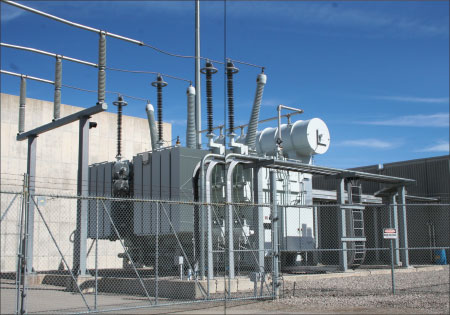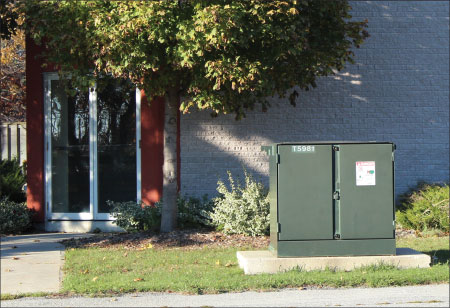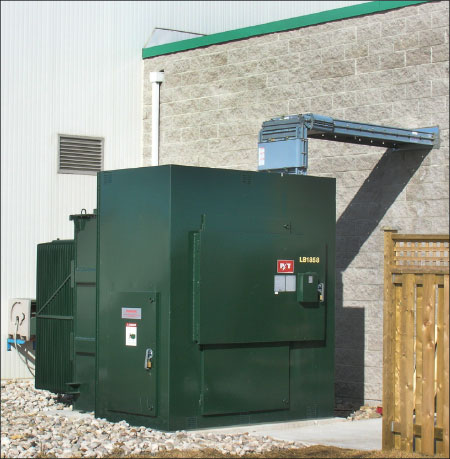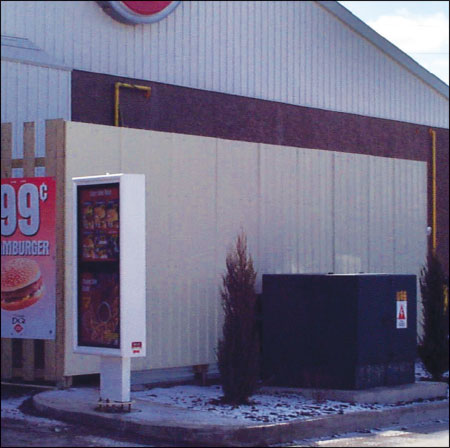The general requirements in the Canadian Electrical Code Part I (CE Code) covering clearance of outdoor oil-filled transformers to a building or openings are not new; in fact, the first edition of the CE Code, dated 1927, had the following requirement.
Rule 2003 (b) Oil-filled transformers shall not be installed on a roof or over or near any window, door or other opening into a building. If attached to a wall, both the wall and the means of support shall be of fireproof construction and the transformers shall be separated from the wall by at least 6 inches.
In the 21 editions of the CE Code since the first edition, the requirements have changed 13 times. The most significant changes are in the editions dated 1953, 1958, 1972, 1978, 1986, 1990, 1994, and 2006. In the 1953 edition, Rule 8-044 (3) required oil-filled transformers in immediate proximity of a building to be placed adjacent to blank walls of masonry or concrete. The 1958 edition was the first to include clearance measurements in the form of Table 38.

Figure 1. Table 38
In the 1972 edition, in addition to moving the requirements to Section 26, the table was deleted and the rule was completely rewritten.
Rule 26-010 Flammable Oil-Insulated Equipment, Outdoor
(1) Electrical equipment containing liquids that will burn in air, in quantities of more than 10 gallons, and installed outdoors, shall not, except as permitted by Subrule (3), be located within 20 feet of:
a. Any combustible surface of material on a building
b. Any door or window; or
c. Any ventilation inlet or outlet.
(2) The dimension referred to Subrule (1) shall be the shortest line-of-sight distance from the face of the container containing the flammable liquid to the building or part of the building in question.
(3) Notwithstanding the requirements of Subrule (1), the equipment may be installed within 20 feet of a building providing a suitable non-combustible wall or barrier is constructed, in a manner acceptable to the supply authority and the inspection department, between the building and the equipment.
(4) Where electrical equipment containing liquids that will burn in air, in quantities of more than 10 gallons, are installed outdoors they shall:
a. Be inaccessible to unauthorized persons;
b. Not obstruct fire-fighting operations;
c. If installed at ground level, be located on a concrete pad draining away from structures or be in a curbed area filled with coarse crushed stone; and
d. Note have open drains for the disposal of flammable liquid in the proximity of combustible construction or material.
The quantities in Subrules (1) and (4) were increased from 10 gallons to 30 gallons in the 1978 edition, and “a suitable non-combustible wall or barrier is constructed” in Subrule (3) was changed to “a suitable fire-resisting wall or barrier is constructed” in the 1982 edition.

Photo 1. Power transformer built to CSA Standard C88.
The 1986 edition has a significant new Subrule (2) added to Rule 26-242.
(2) Liquid-filled pad-mounted distribution transformers shall be installed at least 3 m from any combustible surface or material on a building and shall be installed at least 6 m from any window, door, or ventilation opening on a building.
This change is significant as the measurement is now from a surface or material not the wall. This means the wall can be of combustible construction provided the surface is non-combustible. The other more significant change is that the code now recognises the difference between power and distribution transformers. Rule 26-014 deals with power transformers and other dielectric liquid-filled equipment, and Rule 26-242 addresses distribution transformers. A power transformer is a liquid-filled transformer built to CSA Standard C88 Power transformer and reactor. A distribution transformer is a liquid-filled transformer rated not more than 3000kVA and not more than 34.5kV built to CSA Standards C2.1 Single-phase and three-phase liquid-filled distribution transformers; C2.2 Pole-mounted, single-phase distribution transformers for electric utilities; C227.3 Low-profile, single-phase, pad-mounted distribution transformers with separable insulated high-voltage connectors; C227.4 Three-phase, pad-mounted distribution transformers with separable insulated high-voltage connectors; or C227.5 Three-phase live-front pad-mounted distribution transformers. With that said, not all transformers rated up to 3000KVA and up to 34.5kV are distribution transformers, as the scope CSA Standard C88 covers all liquid-filled transformer sizes and voltages. All transformers built to CSA Standard C88 are required to meet clearances in Rule 26-014.
Changes in the 1990 and 1994 editions recognised the practice of installing a barrier or wall between the transformer and the building to reduce the clearance requirements, provided the surface on the wall or barrier is non-combustible.
A new Subrule (3) was added to Rule 26-242 in the 2002 edition that was amalgamated with Subrule (2) in the 2006 edition to read:
(2) Dielectric liquid-filled pad-mounted distribution transformers shall be installed at least 3 m from any combustible surface or material on a building and at least 6 m from any window, door, or ventilation inlet or outlet on a building, except where
(a) a wall or barrier with non-combustible surfaces or material is constructed between the transformer and any door, window, ventilation opening, or combustible surface; or
(b) the transformer is protected by an internal current-limiting fuse and equipped with a pressure relief device, with working spaces around the transformer of at least 3 m on the access side and on all other sides:
(i) 1 m for three-phase transformers; and
(ii) 0.6 m for single-phase transformers.
Item (b) of this new Subrule (2) allows reduced clearances where the distribution transformer is protected by an internal current-limiting fuse and equipped with a pressure relief device. CSA Standards C227.3, and C227.4 require internal current-limiting fuses, and a pressure relief device on all pad-mounted tramper-resistant distribution transformers built to these standards. Internal current-limiting fuses, and a pressure relief device are optional for transformers built to CSA Standards C2.1, C2.2, and C227.5.

Photo 2. A three-phase liquid-filled distribution transformer built to CSA Standard C2.1

Photo 3. Pole-mounted, single-phase distribution transformer for electric utilities covered by CSA Standard C2.2

Photo 4. A low-profile, single-phase, pad-mounted distribution transformer built to CSA Standard C227.3
Rules 26-014 and 26-242 have remained unchanged from the 2006 edition of the CE Code.
26-014 Dielectric liquid-filled equipment — Outdoors (see Appendix B)
(1) Except as permitted by Subrule (3), dielectric liquid-filled electrical equipment containing more than 46 L in one tank, or 137 L in a group of tanks, and installed outdoors shall not be located within 6 m of
(a) any combustible surfaces or material on a building;
(b) any door or window; or
(c) any ventilation inlet or outlet.
(2) The dimension referred to in Subrule (1) shall be the shortest line-of-sight distance from the face of the container containing the liquid to the building or part of the building in question.
(3) Notwithstanding the requirements of Subrule (1), the equipment shall be permitted to be installed within 6 m of any item listed in Subrule (1)(a), (b), and (c), provided that a wall or barrier with non-combustible surfaces or material is constructed between the equipment and that item.
Appendix B Rule 26-014(3)
The normal enclosure for the equipment is not to be considered as the barrier referred to in this Subrule.
(4) Where dielectric liquid-filled electrical equipment containing more than 46 L in one tank, or 137 L in a group of tanks, is installed outdoors it shall
(a) be inaccessible to unauthorized persons;
(b) not obstruct firefighting operations;
(c) if installed at ground level, be located on a concrete pad draining away from structures or be in a curbed area filled with coarse crushed stone; and
(d) not have open drains for the disposal of the liquid in the proximity of combustible construction or materials.
26-242 Outdoor transformer installations
(1) Except as permitted by Subrule (2), where transformers, including their conductors and control and protective equipment, are installed outdoors, they shall
(a) be installed in accordance with Rule 26-014 if they are dielectric liquid-filled;
(b) have the bottom of their platform not less than 3.6 m above ground if they are isolated by elevation;
(c) have the entire installation surrounded by a suitable fence in accordance with Rules 26-300 to 26-324 if they are not isolated by elevation or not housed in suitable enclosures; and
(d) have conspicuously posted, suitable warning signs indicating the highest voltage employed except where there is no exposed live part.
(2) Dielectric liquid-filled pad-mounted distribution transformers shall be installed at least 3 m from any combustible surface or material on a building and at least 6 m from any window, door, or ventilation inlet or outlet on a building, except where
(a) a wall or barrier with non-combustible surfaces or material is constructed between the transformer and any door, window, ventilation opening, or combustible surface; or
(b) the transformer is protected by an internal current-limiting fuse and equipped with a pressure relief device, with working spaces around the transformer of at least 3 m on the access side and on all other sides:
(i) 1 m for three-phase transformers; and
(ii) 0.6 m for single-phase transformers.

Photo 5. A three-phase, pad-mounted distribution transformer built to CSA Standard C227.4

Photo 6. Three-phase live-front pad-mounted distribution transformer built to CSA Standard C227.5 close-coupled with a high voltage switch

Photo 7. A non-combustible surface installed on a barrier between a distribution transformer and the back door of a restaurant.
To answer the original question, the CE Code does allow an outdoor dielectric liquid-filled transformer 1m of a door or window of a building provided the transformer is a distribution transformer with an internal current-limiting fuse and equipped with a pressure relief device.











Find Us on Socials